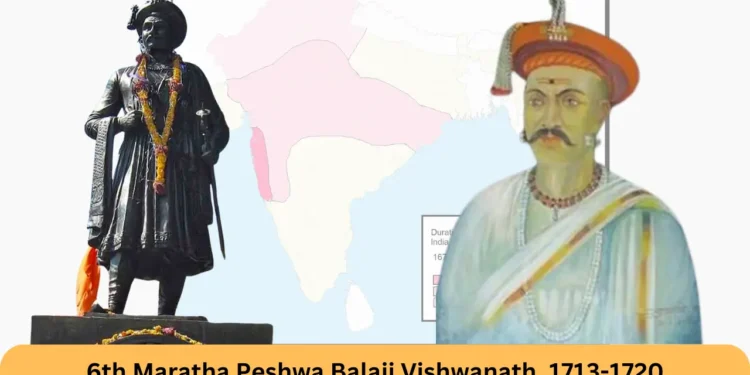The 6th Maratha Peshwa Balaji Vishwanath – from November 1713 to April 1720
In November 1713, Balaji Vishwanath was appointed as the sixth Peshwa by the Maratha ruler Chattrapati Shahuji I (January 1707 – December 1749). Balaji Vishwanath was an able Peshwa. He guided and helped the Maratha ruler, Shahuji I to consolidate the Maratha empire. His role in strengthening, consolidating and expanding the Maratha kingdom is of such a significance that he is called the ‘Second Founder of the Maratha empire’. The first important task was to unite the different Maratha factions and families and bring them together under the control of the Maratha king and Peshwa.
Political Rise of Peshwa Balaji Vishwanath
Some important developments during the tenure of Peshwa Balaji Vishwanath are given below.
Mughals: Peshwa Balaji Vishwanath was well aware about the inner conflict amongst the Mughal nobility and the rulers. He realized that to strengthen the Maratha might, it was necessary to align with the Mughal nobles. The leading noble faction in the Mughal court was that of the Sayyid brothers.
Hussain Ali Khan, one of the Sayyid brothers, was also losing energy in his constant war with the Marathas in the Deccan. The two found it prudent to make peace with each other. Therefore, Balaji Vishwanath and Hussain Ali Khan entered into a Maratha-Mughal treaty. By this treaty Maratha demanded chauth and sardeshmukhi from the Mughal provinces in Deccan, Gujarat and Khandesh.
However, Mughal ruler Farrukhsiyar did not like the agreement and did not ratify it. In February 1719, Hussain Ali Khan, with the support of Maharaja Ajit Singh of Marwar and Maratha Peshwa Balaji Vishwanath, captured, blinded and killed Mughal ruler Farrukhsiyar. Puppet Mughal rulers Rafi-ud-Darajat and Rafi-ud-Daulah were placed on the throne for three months each. Thereafter, in September 1719, Muhammad Shah ascended the Mughal throne.
After the dethroning and killing of Mughal ruler Farrukhsiyar, Peshwa Balaji Vishwanath was able to get Maratha ruler Sahuji and his mother released from the Mughal captivity.
Balaji Vishwanath established the system of jagirdari amongst the Maratha chieftains and nobles. This ensured loyalty of various Maratha leaders to the Maratha king and Peshwa. He also made financial improvements in the revenue collection.
Death and Succession of Peshwa Balaji Vishwanath
Balaji Vishwanath fell sick in April 1720 and died. He was succeeded by his son Baji Rao I as the seventh Peshwa.
Balaji Vishwanath was married to Radhabai Barve. They had two sons, Bajirao I and Chimaji Appa. They also had two daughters, Bhiubai Joshi, and Anubai Ghorpade.
Also read the book “Comprehensive History of Modern India”.
Also checkout the Maratha Story by the Capacity Building Commission of India.



